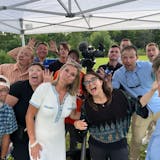For two pandemic years, every cough, every sneeze, has come with a question.
The only way to get an answer — is it allergies, or did you just expose everyone at this salad bar to a whole new letter of the Greek alphabet? — is to get tested.
But getting a COVID test can be a test in itself.
Minnesotans are scrambling for appointments at testing centers or shelling out for over-the-counter test kits, as COVID cases rise, hospitals fill, and holiday travel looms.
Which is how I found myself coughing at the back of a long, long line at a community testing site in the Minneapolis Convention Center last Monday.
Vaccines are like seat belts. They can't stop something from crashing into you — but they will vastly improve your odds of walking away from that crash.
Twice vaccinated, freshly boosted, and coughing like a harbor seal, I set out in search of answers.
My neighborhood's free state-run testing site – one of many around the Minnesota – was closed the day I started coughing. I had other options. I could have hunted the drug store aisles for a rapid test kit. I could have driven around in search of another testing site with appointments available. I could have sent away for one of the at-home saliva test kits the state of Minnesota provides free to all.



